[share_sc]
Note: This is a post from Joan Concilio, Man Vs. Debt community manager. Read more about Joan.
If you’ve followed our family’s story here on Man Vs. Debt for a while, you might know that we have a fairly decent long-term side hustle selling used books and ephemera (old magazines and papers).
Since 2005, we’ve sold those books online via Amazon.com’s third-party seller network, building up to an inventory of almost 3,000 items.
This year, we took a pretty huge step. We delisted all but a handful of those books online, and we rented space in a local antique mall where we’ve been selling these books – and other items – since late February.
Since I’m a HUGE fan of selling your crap online (and especially fond of Amazon), I figured it’d be good today to compare these two business models and explain a bit about why we’ve made this pretty drastic change – and where we see our side hustle going in the future. I hope it’ll encourage you to think about your own hustles and what’s working – or not!
Our Costs
Amazon: One of the best things about selling online via Amazon specifically was that we didn’t pay any fees until items sold. We spent a small amount (less than $25 a month) on envelopes and tape for wrapping, and we paid to ship (though Amazon reimburses a “shipping credit,” so often we came out either even or slightly ahead with that).
Antique-mall stand: Our stand rent is $88 monthly. We’re not paying for shipping supplies (we have enough to cover the remaining books listed for sale online) and we’re not dealing with postage. We need to remit sales tax to our state, but since the mall collects it on top of our listed price (and keeps records of it), all we do is put that money aside and pay it to the state Department of Revenue quarterly. We didn’t have to outlay for any furniture; the shelves and tables we use, we already had.
In both cases, the space in our home used to store books results in a tax deduction; our stand rent also becomes a business expense for taxes in this new model.
Our Time Commitment
Amazon: While selling online is often one of the quickest ways to get an item gone, it gets more and more time-consuming as you “scale up.” Even with a pretty good organizational system, it took us quite a while to find books in our inventory when we received a notice once had sold. Then, we’d spend time wrapping and so on. We also had to be sure to hit the post office almost daily when we were at our busiest. It’s not far from our home (thankfully) but it’s still a chunk of time that has to be available. Finally, because of the requirement to ship within 3 days, we needed to take our inventory offline during times we were traveling.
Antique mall: Interestingly, the antique mall we’ve chosen to vend through has no time requirement for its member vendors. (Some places require you to help out at the desk one to two shifts per month, for instance.) Even so, we’re spending about an hour there once a week, adding new stock and freshening things up. The great thing here is that, if we want to go on vacation, our items keep selling!
Flexibility
Amazon: The amazing thing about Amazon is that you can sell almost anything used – if it’s been made in the past 40-50 years. When you get into older items, especially those of a local nature, it gets harder (and people aren’t looking to buy those on Amazon, either, so if you list, it often doesn’t sell.) We’ve chosen to keep certain items listed on Amazon because they’re of very niche interest. A 1986 rare book that sells for $59.95 but has maybe two dozen interested buyers in the world? DEFINITELY staying listed there!
Antique mall: The flexibility in the antique mall comes in the opposite direction. We can serve another niche by adding items from our huge collection of local-interest ephemera (gathered for another blog I author). We can also add other items – a Betty Crocker complete 1970s recipe library, an interesting owl statue we found at a local auction, an Easter Bunny-shaped cake pan, some of the family collectibles we no longer use.
Branding
Amazon: It’s actually hard to build a “business” as a seller on Amazon. You can sell a lot, but your storefront presence – where people can see all your items in particular – is limited. That’s not a big deal in terms of revenue; if you’re priced correctly and have a good seller rating, you’ll still sell plenty of items. But as you’ll see as I talk more about our goals, we’re hoping to build a larger brand, so that’s been a struggle.
Antique mall: Here, it’s been easy to use the name we want to brand – Papergreat, also the name of my husband’s book and ephemera blog. You’ll see in the photos above that we have a big sign, free Papergreat bookmarks, and so on. As Chris works to build his blog, we’re also developing it as a “brand site,” meaning our future business endeavors can all be easily tied to the same name and theme, with an existing large audience both locally and worldwide!
Our Long-Term Goals
Amazon: Our original plan on Amazon was to sell our own crap. We did that. And we did it so well that we started buying other crap to flip. Again, that went quite well. But as a long-term business, it’s not particularly scalable. We don’t really want to be wrapping and shipping 2, 3 or even 5 books a day and listing 10 more. It’s profitable, but it’s time-consuming, and as a side gig, it’s kind of capped out. Without investing in our infrastructure at a degree we’re not willing to go, we’ve maxed out what we can give – and get – from this business.
Antique mall: This stand is a thought-out step toward our family’s BIG long-term goal. We’d like to own a bricks-and-mortar bookstore. We’d almost certainly still sell selected items online, but we’ve learned a lot about what does and doesn’t work in that space. Now, we’re actively pushing ourselves to learn what works in the real-world retail scene. It’s been a great learning experience. Things we didn’t expect to do well, because they weren’t great sellers online, are moving quickly – like recipe pamphlets and religious odds and ends. That’s what we wanted to do – experiment (in a low-overhead way) in this space.
Our Profit
Amazon: At our highest, we were averaging a gross of $300 to $400 a month on Amazon, but selling about 20 items to reach that total. With our time, mailing supplies and so on factored in, we were netting closer to $150 to $200. Interestingly, we believe that with the few items we still have listed, we can still bring in $50 to $100 a month. The difference is, that’s between 3 or 4 items, drastically reducing our time expenditure.
Antique mall: In our first month and a half, we’ve come out in the black. We didn’t go in expecting to do that, so we’re thrilled! So far, income minus rent has put us about $40 to the good. That’s not bad for the first month, and we expect that to grow.
As a side note, my long-term goal is not to have a guest room filled with 3,000 books and 50,000 pieces of paper, so if nothing else, we’d have to find somewhere else to store it… and I’m basically getting a “storage unit” at the antique mall that actually makes me money instead of costing it!
And in the irony of ironies, the dumb owl that I sat there as our “mascot,” priced at $5, gotten for next to nothing in a box-lot at an auction?
He was the first item to sell.
See? We have a lot to learn about bricks-and-mortar retail.
[share_sc]
This is not a path for everyone. The interesting thing is, we think that we can (eventually) make more money this way, and learn at the same time.
The question I hope you’ll ask yourself about your own crap-selling, side hustles and even full businesses is this: Is what you’re doing serving your long-term goals?
Or should you be trying something new?
I would love to hear your thoughts in the comments!
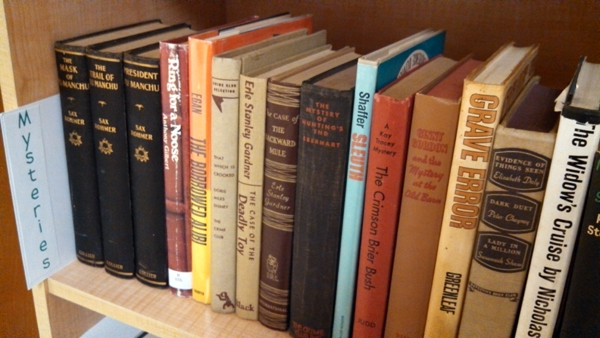
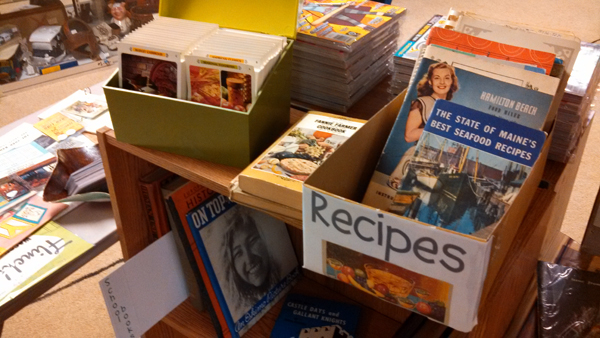
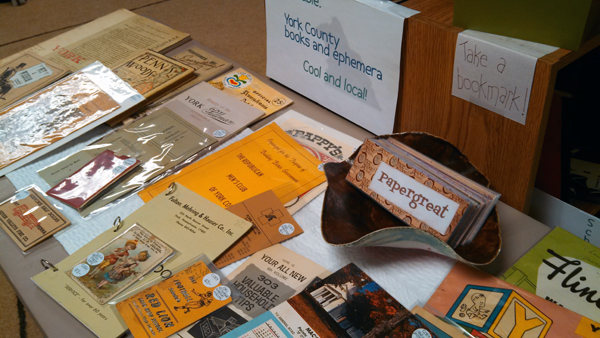
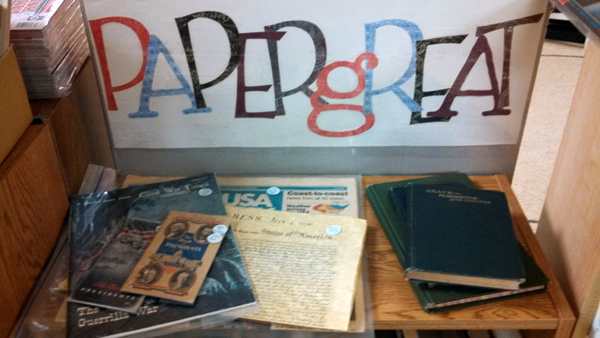
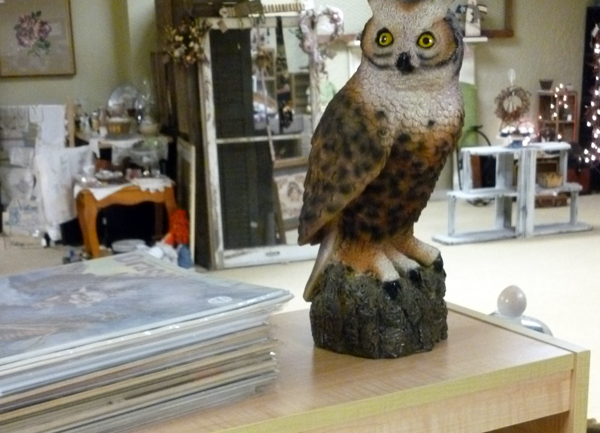
Congratulations that sounds like a plan. Have you ever considered doing
Amazon FBA? That is what I currently do. I send everything into Amazon
and when it sells they ship, do customer service, etc. and I get paid. The
fees are higher than doing Merchant filled but you have more exposure
and most of the time you can command a higher price. The FBA fees
are definitely worth it since I don’t like shipping, storing, etc. I don’t have
to turn my store off when I travel, I can still make money. Just thought
I would throw that out there.
Rebecca, that’s a great point. We did look into it. Unfortunately, some of our items we were selling don’t qualify for FBA! Our math looking at it around last summer (when we started talking about “where to go next”) was that we’d either need WAY more inventory, or way less, for it to be profitable. Now, would we consider doing it for the relatively few items we have left there? That’s worth considering!
Very interesting article – thank you for sharing. I used to sell books on Amazon as well, but I’ve switched to selling online products a long time ago… The antique store model looks fun, but…
“In our first month and a half, we’ve come out in the black … about $40 to the good.”
Assuming you spend only 1 hour a week at the antique store, that’s $40 for 6 hours of work, or $6.67/hour. That doesn’t take into account the time you spent looking for inventory, cleaning it, moving it to the store, etc. I can’t help but wonder: is this more of a hobby and a point of pride (“Check this out – I’ve got my own store!”) or just a small source of passive income that hasn’t really taken off yet?
Grigory, we’re looking at this as a step toward a much larger business – but right now, we’re investing as little time as possible and trying to gain as much knowledge as possible. We expect that in a couple months, this will be a $200-$300 a month profit business, much like our Amazon store was. However, we believe we can do less work than we did for the larger Amazon store, and gain a lot of knowledge, and then decide how to expand.
The difference is that we don’t believe we’re capped out at that level with a physical store. Will we stay at this antique mall? Not sure. Will we expand beyond our current space? Also not sure. But we have more options, not the least of which is because we don’t have to keep these books in our house! 🙂
Stay tuned for future posts. As I said, this is really a small step in a large process for us, so there is much more to share!
Also, Joan, I don’t sell many books on Amazon FBA, I sell health and beauty, toys, etc. The products sell much faster when they are FBA than when they are merchant filled because Amazon promotes the FBA sellers for us. I just think about his every time I read your blog and hope that you find ways to make more money to be able to get out of debt. I know it has been a lifesaver for me. I am rooting for you and hope you are able to accomplish all of your goals.
Ah, that makes sense! The big problem with our items is that most (as antiquities/out-of-print/just plain “old” books) don’t come with any kind of UPC or ISBN, so we’d have to create our own stickering system, which would then kind of defeat the whole “no time” approach!)
We’re really excited. I know to a lot of people even a few hundred extra dollars a month doesn’t sound like a lot, but to us it’s definitely making the difference in us being able to pay off debt faster (especially since it’s one of a many-pronged approach!)
Interesting post. Thank you for sharing information on your side hustle. It’s enlightening and also encouraging to learn what can be done. I had a couple questions.
I didn’t see mention of the time invested to obtain the books. It would seem to me that going to garage sales and auctions would have to be an on-going activity. How many hours per week do you do this?
I also didn’t see mention of the costs of books that don’t sell. You’ve invested in them. What do you do if some of the titles just sit gatherning dust?
Susan, we actually go to very few auctions, and almost no garage sales; if we do, it’s just for fun. Most of our “book inventory” came from some massive one-time purchases from other booksellers getting out of the business – like the time we filled a Uhaul from a dealer about 2 hours from home!
We’ve already more than recovered all our inventory cost (lifetime), so that’s the other cool thing – we REALLY are talking total profit at this point. And we’re not in a rush. We actually just sold something this week at the antique store that we’d listed on Amazon in 2006!
This is fascinating. I’m always looking for ways to earn money on line but I don’t think I would want to go to this extent. I do like getting rid of our extra stuff though! thanks, Amy
It’s not for everyone! It’s interesting, though, to ask yourself the question: Is what I’m doing serving my long-term goal? If your goal is to get rid of your own stuff, I wholeheartedly believe selling online is the way to go. In our case, we’re looking to build a future business and brand, and that means our goals are drastically different than they were when we were selling our own stuff, which was AWESOME online!
Keep up the stuff-selling! 🙂
Great analysis, Joan! I think you’ve nailed this Online vs. Physical Store comparison of our business here on the blog even better than I have in my head thus far. I will throw a few more thoughts and points out there:
— I don’t have the exact figures in front of me, but our Amazon book sales peaked in 2009 and 2010. That’s when we were the most aggressive at book scouting and increasing our online inventory. But even as we were having our best months, you could start to the see the danger signs in the system for third-party sellers of quality used books on Amazon: (1) The recession was chipping away at buyers’ disposable income. (2) E-books were just starting to make a dent in the market; soon, they would be taking huge bites out of the market. (3) Because of how “easy” it had been to make money selling your books on Amazon from 2005-2010, Amazon became flooded with third-party sellers looking for a quick buck. Many of them didn’t know what they were doing. All of them contributed to a flooding of the market, driving down prices; (4) And then you had the huge third-party sellers — Better World Books and many others like it — flooding Amazon with even more books. Rather than an occasional annoyance Penny Books became a way of life. (See: http://www.skipmcgrath.com/articles/amazon-penny-books.shtml ) Obviously, when you’re up against huge-inventory sellers peddling books for a penny, you’re not in a business that’s going to put food on the table.
And so our sales dropped significantly on Amazon in 2011, even though I believe our inventory was at its greatest and we were still scouting and aggressively posting more books for sale. The public appetite for used books on Amazon is no longer the moneymaker it once was.
As sales continued to slow in 2012, there was a lot of lamenting and brainstorming and soul-searching. But there’s nothing to be done about. You can either leave the bookselling business behind, or find the right new formula to move forward with.
We’re still the smallest fish in the pond, but I believe there will be opportunities moving forward for people who love books, understand a little bit about the resale value of used books, have a little business sense (which is what I count on Joan for!) and are willing to be patient and learn.
I don’t know if we’ll be a vendor at the antique mall 12 months from now. I kind of don’t want it to just be the status quo in April 2014. Either we won’t make enough money there to continue that particular experiment, or it will go so well that we will expand our vending space and/or move on to a bigger opportunity. But we’re not going to have all the information we need to make a smart decision on that Next Opportunity without the knowledge we’re gaining every day with this baby step into the world of brick-and-mortar bookselling.
I just have to be ultra-clear here and point out that this is my awesome husband’s take on the whole thing – and I want to give him a big ol’ MvD shout-out. He is AMAZING at this stuff. The things I talked about here, he has analyzed in a ton of depth as we look at our future dreams and career opportunities, and … he rocks!
I’ve been looking to start selling some items online. I was originally thinking about selling on ebay, but now I will have to look into amazon as well. Thanks for the article!
You’re very welcome, Cassi! I am a huge fan of Amazon for a lot of items (books, but other stuff too) and it continues to be the biggest place I sell my OWN used stuff!
Good luck!
Well Joan, first of all if you had asked ME I would have told you that the Owl should have been priced about between $50-$70! Owls are very hot collectibles these days, and that’s how I would have priced it in my online store.
I’ve been selling mainly on eBay and a couple of other smaller sites, but I want to start selling seriously on Amazon. I will do it, though, only if I can do it FBA. I have a friend (my new online selling mentor) who makes regular $1000-$1500 a month from Amazon, and she never ships a darn thing. That’s MY kind of business. And she sources most of her inventory from thrift stores, yard sales and clearance racks at B+M Stores. I want to be her within a year or two!!
I do think that looking into an antique mall is an interesting idea… I have never been to one, and I am not sure exactly how they work – but it sounds like it’s working well for your type of sales (I don’t want to do books – I’d be more of household items…).
I think the main thing that really strikes me is this…. so many people think that they need to work at a “job” which means a cubicle or some such thing. But if you are capable of a little thought outside of the box, there are so many different ways to do! And no one business model is right for everybody. You have to find what works best for you.
I agree so much with what you’ve taken from this. The point isn’t getting rich quick. The point is finding something that is profitable (in the literal sense, not a money-loser – not necessarily meaning “pays all your bills”) and building it IF it’s what you enjoy doing!!
File this in the ‘for what it’s worth’ column…. several years back when I had a music CD store at a weekend market, I would experiment with pricing. If I had an item in inventory for a long time, I’d put it behind the counter for a week or two. Then, before I’d return it to the shelf, I’d double the price. More often than not, it would sell within the first couple days! (Other vendors at that market confessed to doing the same thing with similar success).
Try it and let us know if it works for books!
Doug, we were talking about that today – it’s hard to believe, but we have heard the same thing, so… we’ll probably give it a try!
Joan, thought this might be of interest. This morning I came across a blog post by Nate Otto (any relation?) that touches on our previous discussion about raising prices….
https://37signals.com/svn/posts/3493-million-dollar-art
Joan,
I think you hit on the key with time involvement. Your $40 for 6 hours work actually cost you more with travel expenses and prep time. (can’t go to the bookstore in PJs.).
My wife and I have rental properties and p2p investments. While I am a bit of a hobbyist on p2p, it takes me about 5 minutes per day. We have property managers for our rentals. While we are active owners, it rarely takes more then 3-4 hours per month. We plan to double that passive income this year. I looked into amazon and ebay and the time commitment just didn’t add up for us.
Jason
That’s true – but – our goal isn’t passive income. So we’re not really looking at it that way.
Or, you could look at it this way: Passive income = money made while you pursue your hobbies/interests. So, we go to the antique mall anyway (to browse). We write our personal websites anyway, so added branding support = bonus. We go to estate sales as our “dates” (and were doing that before we sold anything).
We COULD devote zero time to the store once it was set up. That’s an option. We just consider the time we spend “fun,” not “work.” Semantics, but it really does matter to us. We want to open a physical bookstore because we can’t imagine anything cooler than spending our days in a store full of books with people who like to talk about books visiting us. That’s definitely not passive income. But it’s FUN!! 🙂
Love it Joan! This will be my first month back in a shop. For many years I rented a spot and it was great! I love it but over time it burnt me out and cost me more money than it was worth at the time. Now I am back refreshed and in need of a side hustle. Like your owl, I had found a cute shelf, cleaned it up, over priced it because I didn’t want it to sell. And it sold in less than 3 days for $180, I was hooked after that. You’ll love it I know you will. Keep us posted.
NICE, Tina! We sure aren’t as big-ticket as that, though we have some items that’ll get a little higher-priced, and we can’t wait to see those move too! 🙂
Very cool, Joan. I really liked reading about your transition from online Amazon store to the antique mall. Very cool. It resonates with me because I would like to have a little coffee shop one day with a robust used books section, so it’s some good food for thought.
We would love to visit your coffee shop! 🙂
That sounds like a great plan Joan.
I do find myself wondering though about the extra expenses that come along with selling via an actual physical space? I mean you not only have the rental costs. You also have the extra expense of physically having to man the store yourself. Not to mention the fact that for more speciality items the internet is almost always going to provide more buyers.
Still, definitely an interesting experiment. I will be interested to see in future months how it all pans out!
Jason, that’s the thing – we don’t have to man the store at all. And we’re still listing the specialty items online, for exactly the reason you’re talking about – the example I gave in the post of the book with about 6 interested parties worldwide is exactly it!
You have quiet a book collection. How long did it take you to build that collection? I have a nice collection but wouldn’t think of selling them since I still read them back every once in a while.
Kevin, most of these weren’t “ours” – we buy in bulk to resell, but we keep any we want “off the top!” Believe it or not, we have a relatively small personal book collection, though we love to read. We just don’t love too many books enough to keep them after they’ve been read. (That said – by minimalistic standards, our family book collection is probably considered huge – multiple shelves – but compared with the volume we do in and out for the book sales business, it’s a fraction!)
Bookselling is one of the harder products to get by in, i can say from experience. It is difficult to know what sells, and then when you find out, it can change again. That’s bookselling!
Have you considered your own website rather than selling on other venues? Maybe make it a specialty store for the more rare or unusual books?
Thanks so much for this analysis! I collect vinyl records and have amassed a few thousand that I want to get rid of. Selling at an antique mall appeals to me, but I’m perplexed when it comes to the tax reporting. I save receipts for my purchases (excluding for those records bought at flea markets), but figuring out the original purchase price of each record–to calculate profit–would be a nightmare to say the least. Any advice here? Is there a way of estimating? Also, any idea by how much rental expenses are offset by the tax deduction you’re able to take? Finally, is quarterly reporting required when you make so little ($400 tops) from the business? I assume you do your own taxes instead of using a tax preparer like H&R Block. Thanks again for this helpful website.
Your story is similar to mine in a way. I started building a “business” on Amazon two years ago but found that growing it became more of a job, with pressures, than the hobby I wanted. Constant sourcing, worrying about reporting sales tax in a growing number of states, etc. I’ve shifted my time to a booth at an antique mall that is far more forgiving with a lot less stress. It’s still earning less than Amazon was, but it’s easier for me. My wife and I are just finding our niches at the booth and hope to have a steady income from it soon. Nothing to retire on, but one that will help pay down debt.